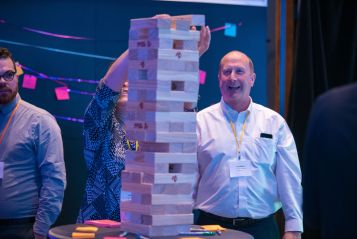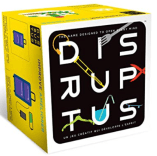3 Key Takeaways from Engaging Association Forum 2019
1- There is power within you to make change
Chris Cummings said: “There is a power within you to make change and it starts with small acts. By taking those steps you help others take steps towards their improvement and change.” We believe technology is a powerful tool to enable positive change. But technology alone is not enough we must better understand human behaviour to understand how the technology will change it. Combining those two elements is the most impactful way to create change.
2– Choose the high Impact results driven activities
Erin said: “Don’t just add solutions or services increasing complexity. Choose the high impact results driven activities your associations can offer members. Then be critical about activities that don’t provide value and remove them” The same is true when it comes to AV. Pick the technologies that reinforce your associations story and value proposition. When FMAV designs solutions, we focus on the transformational change they can create. If a technology does not provide enhance or reinforce the human connection, it should be eliminated in favour of one that does.
3- Get unscripted
Jennifer Spear asked us to “get unscripted, it might be a little scary, but all the uncertainty and ambiguity opens up many new opportunities that might not have been evident otherwise.” FMAV believes events are a never-ending prototype. An opportunity to experiment with innovative design strategies and technologies. Overtime that experimentation evolves your stakeholders experience. Improving and enhancing their connections to other stakeholders and your instructional content. By understanding your event goals and stakeholder objectives we limit the risks associated with being “unscripted.” Together with our clients we design towards our shared goals, knowing that together our process and alignment will enable us to make smart choices.
Creative and Design Zone Prototype Audit:
Through the EventCanvas design process the Engaging Association Forum (EAF) design team identified that Executive and Planner attendees wanted to have the opportunity to experiment with new activation techniques and experience innovative design strategies hands on. To empower this, FMAV created several experiences for the attendees.
What worked:
- “Silent Breakout” in the main room. We received very positive feedback from both attendees and presenters regarding this style of delivery. Although a little foreign at first everyone embraced the idea in practice and many suggested it was a good way to use one room and keep the entire community connected and intimate. Some commented that they were considering “making their entire event happen on the tradeshow floor using the head set technology”. FMAV can provide strategy, pricing and technology guidance to activate this at your associations event.
- The engagement walls: Encouraging people to contribute to the conversations around business and personal challenges was well received. People liked the technology and analogue tactile nature of the activations. Many said the topics and activities spurred conversations during lunch and created many great opportunities to learn from their fellow attendees. Peer group learning is often overlooked or under activated at events. Planners often focus on the keynote stage presentations and do not allow time for attendees to share learning and experiences with their peers. The engagement walls did a good job to getting conversations started and encouraged people to share their experiences that might have been missed without the catalyst to share.
- Shift your thinking games and cards:

Many attendees said the card games were an interesting addition. Several commented that they would like to utilize them at their internal board meetings to help get the creative thoughts flowing. The favourite was Event Cards by Designing. Events, many attendees liked how it had tangible recommendations and how the cards linked to each other helping the design team to uncover opportunities to create one activation that achieved multiple positive outcomes
- The EventCanvas Design Space: The Event Canvas design space allowed people to see the steps that were taken to understand the events stakeholders. It allowed people to learn more about the methodology and ask questions from practitioners. Several attendees have used the methodology and were very happy to share their experiences and how it impacted their events. This has been the most talked about activation post event. With several associations taking steps to apply it to their next conference. Contact FMAV to find out more about how you can learn the methodology and how it can be applied to designing your event.
What didn’t:
- Virtual Reality: Like a lot of VR activations at live events FMAV struggled to get people fully engaged in the solution. When an events focus is on inter personal interactions VR can often derail that aim. When a person puts a VR headset on they are full immersed in the virtual environment. Which is handy if
 you want undivided attention. But, it does remove that individual from the group experience. This can deter people who are already feeling connected with their peers and fear the distraction will push them out of the loop. VR works great as a training tool, Tradeshow environments benefit from it especially. But its deployment must be heavily strategized to get the best results.
you want undivided attention. But, it does remove that individual from the group experience. This can deter people who are already feeling connected with their peers and fear the distraction will push them out of the loop. VR works great as a training tool, Tradeshow environments benefit from it especially. But its deployment must be heavily strategized to get the best results.
Several attendees were interested in the way FMAV uses VR to help planners previsualize what their room design will look like. The concept of allowing the CEO or other presenters feel like they are on the stage before they get to the real-world example is very empowering and helps to build confidence in that presenter. Several also expressed an interest in learning more about the unique educational delivery methods VR can offer.
Games, Games, Games:
FMAV provided some fun games to encourage people to unlock their thinking. Some people got into them while others were more interested in the networking activations. This outcome was anticipated but the experiment was worth the effort anyway. For future events the EAF organizers and FMAV will better understand the style of game to install and how attendees will interact with them.
Games engaged:
GeoMod Stage Set Designer (people have asked for their stage set to be priced out. If you forgot to ask or want to design your own ask us for more details)
Fast puzzles. People like to win quick and move on.
Giant Jenga. Because it is fun!

Games that didn’t engage:
Paper plane Fly Win competition. Just not this groups cup of tea. They are looking for tangible activities that teach them something and/or increase their sense of community. This might have been more embraced if activity time was allocated to it and a final competition was held.
Complex puzzles. They distracted people from interacting with each other.
We always encourage event planners to experiment. We learn from experiment and evolve the experience until we have a well focused set of activities that are targeted towards specific attendee personalities and event outcomes. Trying new things can be risky and stressful, but when new and exciting ideas are a hit it out weighs the misses. The key is to really dig into who you stakeholders are and what’s important to them. Then push them a little out of their comfort zone a little and measure the changes until you hit positive improvements in their behaviour.
Games used:
FoxMind Games Disruptus: : An Award-Winning Card Game Designed to Open Every Mind

Thinkpak: A Brainstorming Card Deck : A creative thinking Toolbox
Designing Event Event Cards: Designing.Events is a new research based method to easily design innovative events that matter.






Comments